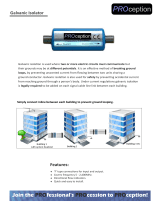Page is loading ...

www.dfi.com / [email protected] / +886 (2) 2697-2986
Bridge Crane solution provides one-off
customization and worry-free management
DFI's EC511-SD series is equipped with the
sixth-generation Intel
®
Core™-i processor and Intel
®
Q170 chipset, providing high-performance computing
and excellent graphics. The EC511-SD series has many
industrial-grade I/O interfaces and PCIe expansion
slots, bringing ideal solutions to high-end intelligent
applications such as mechanical automation, AOI
systems, and monitoring. The EC511-SD series also
realizes the smart production of Industry 4.0.
Region:
Industry:
Application:
Solution:
Taiwan
Foundry, LCD panel assembly
Bridge crane
EC511-SD

An overhead crane, commonly called a bridge crane,
is a type of crane found in industrial environments.
An overhead crane consists of parallel runways with
a traveling bridge spanning the gap. A hoist, the
lifting component of the crane, travels along the
bridge. Every year in the modern ports of the world,
tens of thousands of containers and bulk goods
come in and out through bridge cranes. Unlike
mobile or construction cranes, overhead cranes are
typically used for either manufacturing or
maintenance applications, where efficiency or
downtime are critical factors. The unmanned use of
bridge cranes is necessary for highly automated
production plants such as advanced wafer fabs in
Taiwan.
However, the bridge crane also brings many
additional requirements and challenges to industrial
computers. First of all, the number of COM ports
used to connect mechanical components must be
sufficient and compatible with protocols such as
RS-232/422/485 and must have galvanic isolation
protection to meet the high-voltage industrial
environment. Secondly, the operating bridge cranes
are anywhere from seven to eight feet above the
ground, or even higher. When a failure or a system
crashes, it will not be easy to quickly repair and
freeze the entire bridge line.
A world-renowned foundry in Taiwan and a leading
LCD panel assembly manufacturer originally used
industrial computer solutions that lacked sufficient
COM ports and galvanic isolation protection. Several
USB interface COM ports must be indispensable. The
other cord increases the cost, making the cabling
more complicated and taking up much internal
spaces. The old solution does not support
out-of-band (OOB) management. Once a failure
occurs, it will take a longer and time-consuming
follow-up repairs, reducing the production line's
efficiency. Both tangible and intangible losses are
expensive.
The DFI customized EC511-SD system has a flexible
expansion card, it is able to provide four COM ports
with galvanic isolation protection and can also
support RS-232/422/485 by adjusting the jumper to
improve deployment flexibility. The built-in power
2
DFI Application Story
Bridge Crane solution provides one-off customization and worry-free management

over ethernet (POE) directly supplies power to the IP
camera. The EC511-SD based on the Q170 chipset
corresponds to the Intel vPro platform and supports
iAMT active management technology. When the
bridge crane's control computer encounters a failure,
it can be rebooted remotely via the wireless network
immediately without any effort.
DFI Application Story
Bridge Crane solution provides one-off customization and worry-free management
3
EtherCAT
Master
Isolated
RS-232
PIO
Barcode
Position
Detection
Distance
Measurement
TemperatureElectric Meter
Walking
Lifting
Side Shift
Rotation
Motor
Motor
Motor
Motor
Front
Fall Preventing
Rear
Fall Preventing
Front
Steering
Rear
Steering
Motor Motor Motor Motor
Peripheral
Devices
Peripheral
Devices
Motor
Gripper
EC511-SD
RS-485
RS-485 RS-422
EtherCAT
EtherCAT
I/O
EtherCAT
Isolated
RS-422/485
RS-232

After upgrading the old system to DFI’s EC511-SD,
the complicated USB interface COM port cable is
omitted. The internal structure of the unmanned
bridge crane is more straightforward and more
reliable, therefore, improving the operating
efficiency of the fab. It also virtually helped Taiwan
consolidate its world-leading position in the foundry
field.
Finally, EC511-SD supports a 15-year long-term
supply of CPUs until the fourth quarter of 2030 and
has a diversified selection of processor models,
which makes the use of EC511-SD occur with no
worries.
Founded in 1981, DFI is a leading global provider of
high-performance computing technology across
multiple embedded industries. With its innovative
design and premium quality management systems,
DFI's industrial-grade solutions enable customers to
optimize their equipment and ensure high reliability,
long-term life cycle, and 24/7 durability in a breadth
of markets, including factory automation, medical,
gaming, transportation, smart energy,
mission-critical, and intelligent retail. The robotized
bridge crane will also be the boundary where DFI
brings higher value to the semiconductor and LCD
panel industry.
4
Please click or scan the QR code
to fill out an inquiry form if you
would like us to contact you.
DFI Application Story
Bridge Crane solution provides one-off customization and worry-free management
“Taiwan remains the largest
semiconductor production material
buyer globally in 2020 and 2021, with
its major foundry operators and
integrated circuit packaging and
testing service providers keen to
expand capacity and upgrade
technology. Manufacturing
automation does matter to keep
relentless in the foundry business.”

Founded in 1981, DFI is a global leading provider of
high-performance computing technology across
multiple embedded industries. With its innovative
design and premium quality management system,
DFI’s industrial-grade solutions enable customers
to optimize their equipment and ensure high
reliability, long-term life cycle, and 24/7 durability
in a breadth of markets including factory
automation, medical, gaming, transportation,
smart energy, defense, and intelligent retail.
Website: www.dfi.com
eStore: estore.dfi.com
For more information, please contact your DFI regional sales
representative or send us an email: [email protected]
Copyright © 2021 DFI Inc. All rights reserved. DFI is a registered trademark of DFI Inc. All other trademarks are the property of their respective owners.
/


